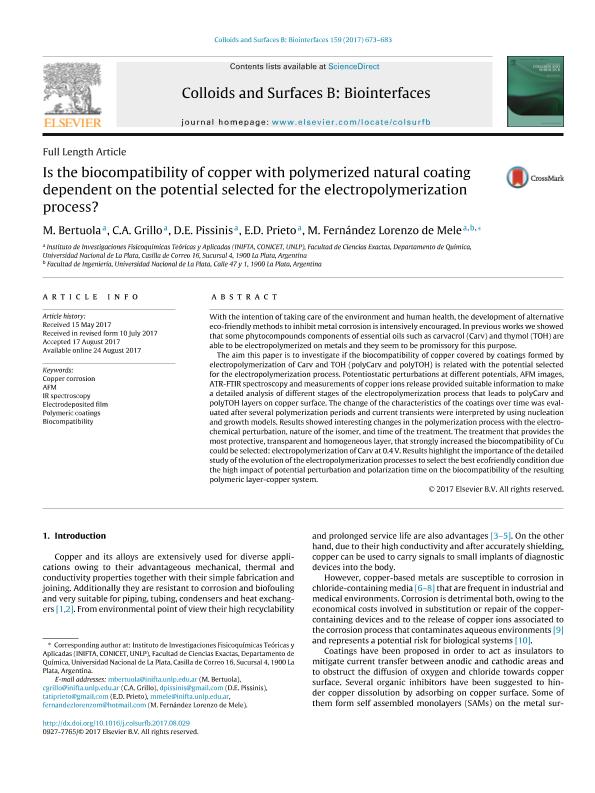Artículo
Is the biocompatibility of copper with polymerized natural coating dependent on the potential selected for the electropolymerization process?
Bertuola, Marcos ; Grillo, Claudia Alejandra
; Grillo, Claudia Alejandra ; Pissinis, Diego Ezequiel
; Pissinis, Diego Ezequiel ; Prieto, Eduardo Daniel
; Prieto, Eduardo Daniel ; Fernandez Lorenzo, Monica Alicia
; Fernandez Lorenzo, Monica Alicia
 ; Grillo, Claudia Alejandra
; Grillo, Claudia Alejandra ; Pissinis, Diego Ezequiel
; Pissinis, Diego Ezequiel ; Prieto, Eduardo Daniel
; Prieto, Eduardo Daniel ; Fernandez Lorenzo, Monica Alicia
; Fernandez Lorenzo, Monica Alicia
Fecha de publicación:
11/2017
Editorial:
Elsevier Science
Revista:
Colloids and Surfaces B: Biointerfaces
ISSN:
0927-7765
Idioma:
Inglés
Tipo de recurso:
Artículo publicado
Clasificación temática:
Resumen
With the intention of taking care of the environment and human health, the development of alternative eco-friendly methods to inhibit metal corrosion is intensively encouraged. In previous works we showed that some phytocompounds components of essential oils such as carvacrol (Carv) and thymol (TOH) are able to be electropolymerized on metals and they seem to be promissory for this purpose. The aim this paper is to investigate if the biocompatibility of copper covered by coatings formed by electropolymerization of Carv and TOH (polyCarv and polyTOH) is related with the potential selected for the electropolymerization process. Potentiostatic perturbations at different potentials, AFM images, ATR-FTIR spectroscopy and measurements of copper ions release provided suitable information to make a detailed analysis of different stages of the electropolymerization process that leads to polyCarv and polyTOH layers on copper surface. The change of the characteristics of the coatings over time was evaluated after several polymerization periods and current transients were interpreted by using nucleation and growth models. Results showed interesting changes in the polymerization process with the electrochemical perturbation, nature of the isomer, and time of the treatment. The treatment that provides the most protective, transparent and homogeneous layer, that strongly increased the biocompatibility of Cu could be selected: electropolymerization of Carv at 0.4 V. Results highlight the importance of the detailed study of the evolution of the electropolymerization processes to select the best ecofriendly condition due the high impact of potential perturbation and polarization time on the biocompatibility of the resulting polymeric layer-copper system.
Archivos asociados
Licencia
Identificadores
Colecciones
Articulos(INIFTA)
Articulos de INST.DE INV.FISICOQUIMICAS TEORICAS Y APLIC.
Articulos de INST.DE INV.FISICOQUIMICAS TEORICAS Y APLIC.
Citación
Bertuola, Marcos; Grillo, Claudia Alejandra; Pissinis, Diego Ezequiel; Prieto, Eduardo Daniel; Fernandez Lorenzo, Monica Alicia; Is the biocompatibility of copper with polymerized natural coating dependent on the potential selected for the electropolymerization process?; Elsevier Science; Colloids and Surfaces B: Biointerfaces; 159; 11-2017; 673-683
Compartir
Altmétricas



